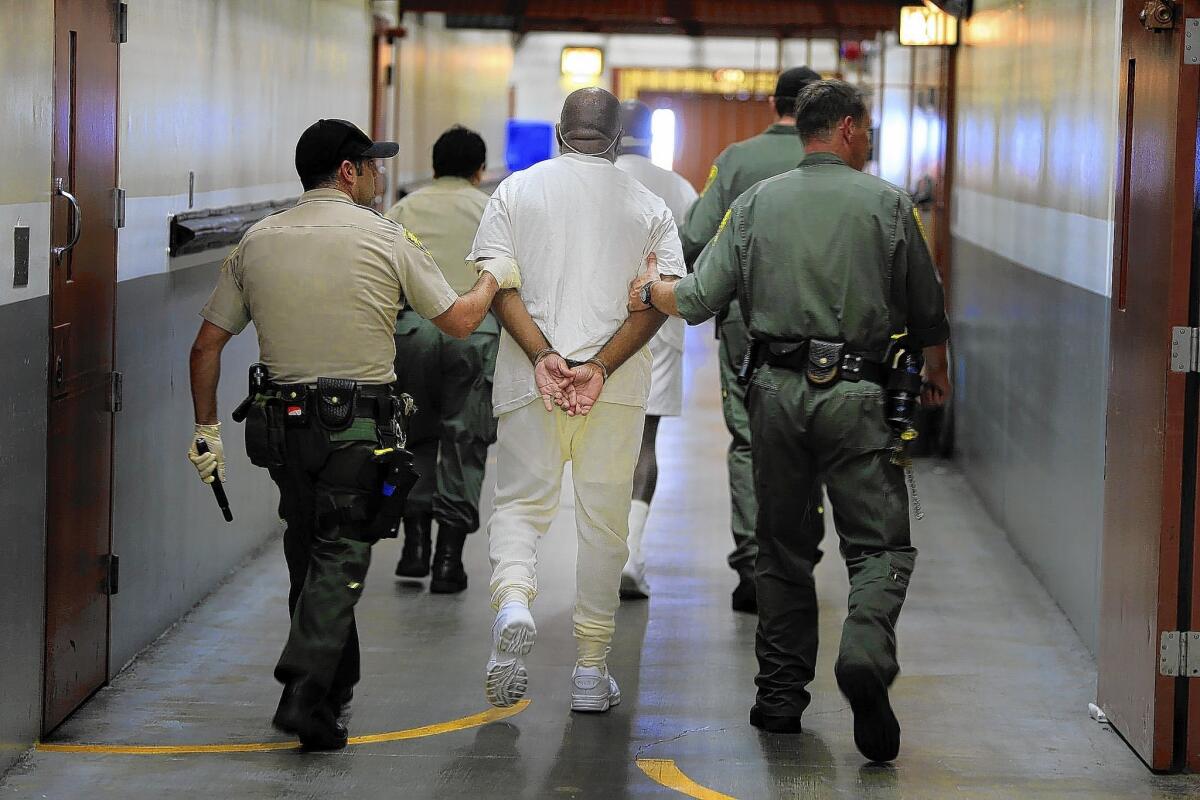Gov. Jerry Brown’s prison reforms haven’t lived up to his billing

Reporting from Sacramento — Nearly 15 months after launching what he called the “boldest move in criminal justice in decades,” Gov. Jerry Brown declared victory over a prison crisis that had appalled federal judges and stumped governors for two decades.
Diverting thousands of criminals from state prisons into county jails and probation departments not only had eased crowding, he said, but also reduced costs, increased safety and improved rehabilitation.
“The prison emergency is over in California,” Brown said in early 2013.
The numbers tell a different story.
Today, California is spending nearly $2 billion a year more on incarceration than when Brown introduced his strategy in 2011. The prisons are still overcrowded, and the state has been forced to release inmates early to satisfy federal judges overseeing the system.
Counties, given custody of more than 142,000 felons so far, complain that the state isn’t paying full freight for their supervision. Many jails are now overcrowded, and tens of thousands of criminals have been freed to make room for more.
“The charts are sobering,” Senate Public Safety Committee Chairwoman Loni Hancock (D-Berkeley) said at a hearing this year on crime, prison costs and inmate numbers.
Still, Brown insists his plan is working, although he has conceded that change can be slow. “It is not going to create miracles overnight,” he said as he returned to his office from a Capitol rally for crime victims earlier this spring.
The governor’s office has embraced the idea that much of the incarceration, probation and rehabilitation cycle should take place on the local level, instead of being left to the state.
Putting prisoners back in local hands “is encouraging and stimulating creative alternatives,” he said.
“Sometimes we get a problem,” he said, and “the solution makes things better than what we had before.”
::
In the Kings County jail, scores of prisoners are stacked three high in steel bunk beds. The jail ran out of room soon after Brown’s program began redirecting prisoners to the county, Sheriff Dave Robinson said.
Although he could have released some, Robinson instead rolled out mats and borrowed dozens of triple bunk beds from nearby Avenal State Prison.
They were the same ones that Gov. Arnold Schwarzenegger had called a public safety hazard in his emergency declaration over prison crowding in 2006.
The steel gray bunks filled with men in green-and-white striped uniforms line the open spaces at the Kings County Jail. “We’re doing what the state did,” Robinson said.
The shifting of prisoners to local control, known as “realignment,” attempts to address the consequences of three decades of tough-on-crime legislation, including measures that date to Brown’s first turn as governor.
In 1976, he signed a watershed sentencing law that prescribed fixed terms for most crimes — a move intended to eliminate sentencing disparities. Two years later, Brown signed a mandatory parole law that increased the time prisoners must be supervised after prison from one year to three.
Determinate sentencing enabled lawmakers to pass hundreds of increasingly stricter sentences for crimes.
In 1994, voters passed the ultimate extender — the “Three Strikes and You’re Out” initiative. It doubled the terms of second offenders and made even a minor third felony conviction a lifetime commitment.
Mandatory three-year parole bounced so many felons back behind bars on violations that by 2006 they accounted for two-thirds of annual prison admissions, according to a study by University of California criminologists.
Prison populations soared.
There were 34,000 state prisoners when Brown left office in 1983; by 2006, the prison population hit its peak with more than 173,000.
Federal judges, who already had taken over control of prison medical and psychiatric programs because of “horrific” conditions, declared in 2009 that California’s overcrowded prison system violated inmates’ civil rights and ordered the population in its 33 prisons capped at about 110,000.
Brown’s realignment solution when he took office in 2011 required creating a new category of criminal — the non-serious, non-violent, non-sex-offender felon.
The “triple-nons” already in prison would head to county probation when they got out. Instead of three years, they could finish supervision in as little as six months. Those committing new crimes would serve their entire sentences in jail rather than state prison. Parole violators would also go to county jails.
In theory, the state would reduce its prison population and save money. Local authorities would take a more active role in rehabilitation and parole — an approach Brown saw as more efficient and effective. “You have to take care of your own,” said Diane Cummins, Brown’s special advisor on realignment.
The reality, however, is that realignment fell short of Brown’s promised achievements.
The prison population fell sharply at first, dropping from 162,400 to 133,000, but it is rising again. There now are 135,400 inmates in state custody, a number expected to grow to 147,000 in 2019.
The state Finance Department originally projected that realignment would reduce prison spending by $1.4 billion this fiscal year and that about two-thirds of that savings would be passed on to counties to cover the costs of their new charges.
Instead, the state’s increased costs for private prison space and the compensation it pays out for county jails, prosecutors and probation departments adds up to about $2 billion a year more for corrections than when Brown regained office.
Without stemming the flow of prisoners into the system, the problems created by crowding continue. The Little Hoover Commission, an independent state agency that investigates government operations, said in a May report that realignment simply “changed the place where the sentence is served.”
One of the biggest effects of realignment is that state and local authorities are releasing inmates early.
From October 2011 to June 2013, California jail releases increased by 45,000, according to state data. The biggest rise has been a doubling in the number of inmates freed before doing half their time.
San Joaquin County holds parole violators as little as one day, and Fresno County sometimes refuses to accept any. Los Angeles County is releasing offenders who serve as little as 10% of their sentences.
On any given day, Los Angeles County has 4,300 offenders walking the streets who would be in jail if there were room, said Assistant Sheriff Terri McDonald, who oversees the jail system.
Although there is no hard proof, politicians, researchers and law enforcement officials are debating whether realignment is behind a recent 8% rise in property crime, reversing years of decline.
Brown’s advisors counter that freeing jail inmates is safer than releasing state prisoners. But that too is happening.
Under federal orders, the state in April and May freed a total of more than 800 prisoners. On July 1, California will relax criteria for medical parole, allowing an estimated 900 inmates to be considered for release; in October, a new parole program begins for prisoners over age 60.
With those agreements, Brown has convinced the courts to push back the deadline to end crowding, originally set for 2013, to 2016.
County officials say that realignment has forced jails and probation departments to rethink their roles.
Jails — primarily built to hold people awaiting trial or convicted of minor crimes — are being expanded to confine and rehabilitate inmates serving sentences as long as 42 years, a cost to California taxpayers so far of $1.7 billion.
Contra Costa County Undersheriff Mike Casten said he is struggling with a tougher inmate population that now mirrors the state’s. “Our jail population is really distilled to the worst of the worst,” he said.
In his county, the jails are also struggling to start rehabilitation programs that were not a focus when prisoners stayed for much shorter sentences, Casten said. A 240-bed jail addition will double the space for counseling, therapy and education programs, but there is no money to actually operate the programs.
Next year Sacramento will send counties $1 billion to offset their costs. But the checks from the Capitol have barely filled the holes left by past budget cuts, leaving little for treatment or classes, Sheriff Robinson of Kings County said.
Brown administrators say they want to use the prison crisis to force larger and more lasting changes in incarceration, primarily by making local authorities assume a larger role.
Matthew Cate, who ran Brown’s corrections department until he left last year, said jail crowding and budget shortfalls create the impetus to make counties reconsider who they lock up and how. “Never waste a crisis,” he said.
And Cummins, Brown’s realignment advisor, said the state’s goal is to encourage counties to reevaluate day treatment centers, counseling, education and job training as alternatives to jail — or, as she put it, “to evolve.”
“They cannot do business the way they were doing it,” she said. “So we tried to give them the tools … to step back in the county and manage the whole community corrections system.”
More to Read
Sign up for Essential California
The most important California stories and recommendations in your inbox every morning.
You may occasionally receive promotional content from the Los Angeles Times.











